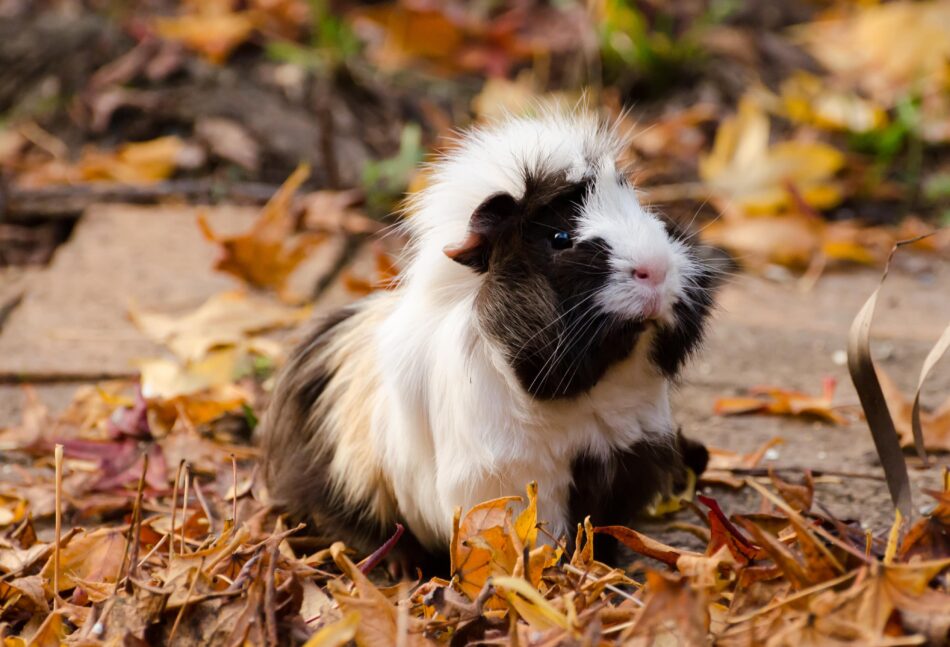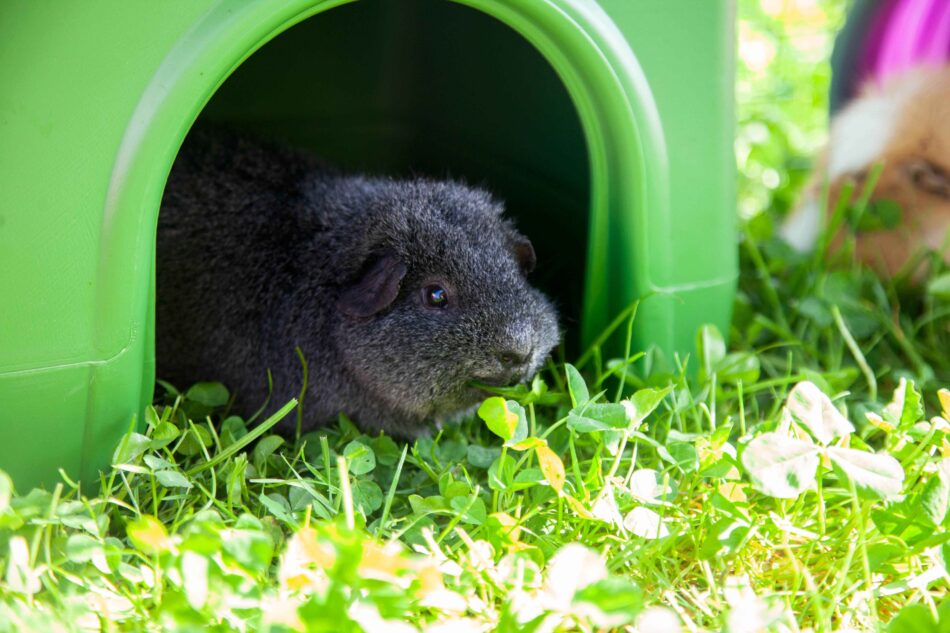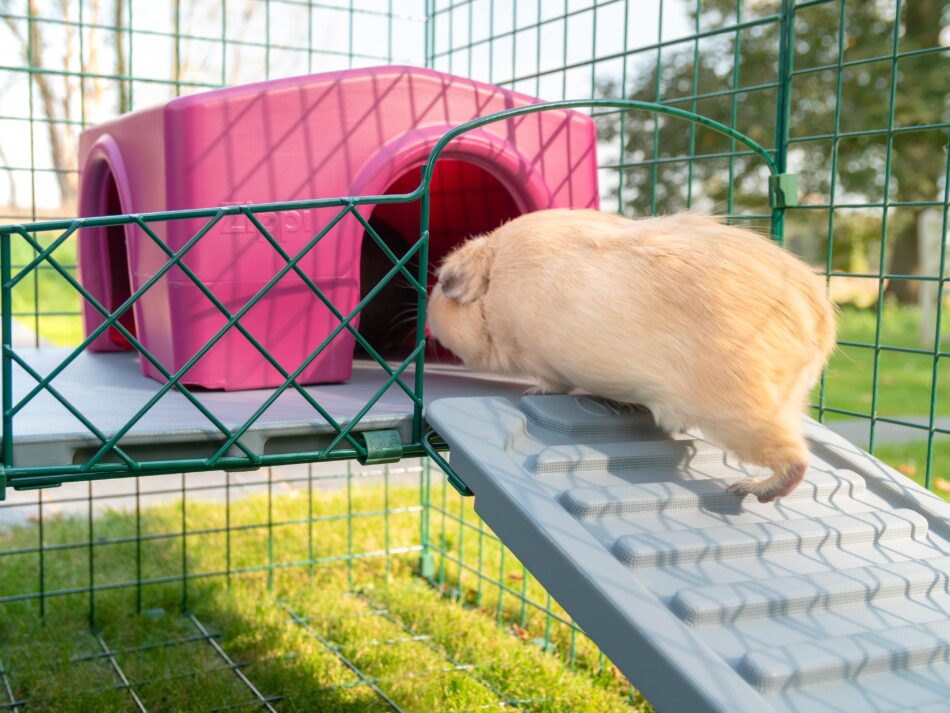Cavy Coats – The Many Colors and Textures of Guinea Pigs

Did you know that there are many different breeds of guinea pigs? There are actually 13 breeds recognized by the American Cavy Breeders of America (ACBA), and several other varieties that have emerged through selective breeding. Some are larger than others, and their personalities differ slightly between breeds – but overall the biggest difference between types of guinea pigs is their coats. A guinea pig’s fur can be short, long, straight, curly, or in the case of “skinny pigs,” non-existent!
Some guinea pigs have such long hair that they appear as though they’re wearing skirts, and some have tight, curly hair that gives them a fluffy appearance. Among the 13 recognized breeds from the ACBA, 5 are long-haired, and 5 are textured! So what people commonly think of when they visualize guinea pigs (short hair with various markings), is actually a minority of guinea pig breeds.
“Skinny pigs” (hairless guinea pigs), dalmatian guinea pigs, and fox guinea pigs are all examples of “experimental” breeds that have emerged recently. Experimental breeds are those that are selectively bred for a desired trait, and once that trait can be replicated for several generations, can one day become a recognized breed at a national level.
Even though some breeds may require more grooming than others, on the whole guinea pigs remain one of the best starter pets for children, and some of the easiest small animals to take care of. Discover the many coats of cavies, and how to choose the right guinea pig for you!
Hair or fur?
Does a guinea pig have hair or fur? Or is there a difference?
Hair is an individual component of fur, which is the collective term. Technically all mammals have fur, because they are covered in hairs – including humans! Hair can also be defined as ever-growing length that is independent of fur, which grows to a definitive length and does not require trimming.
Like most mammals, guinea pigs have fur that covers their bodies. In fact, they are precocial, which means they are born with fur, teeth, and the ability to walk! But longhaired breed guinea pigs have coats much like longhaired dogs and cats that grow continuously throughout their lives.
The fur on guinea pigs serves the same purpose that it does in all mammals – insulation, protection from elements, and of course, visual appeal! But one type of guinea pig, known as the “skinny pig,” has actually been bred to be completely hairless, save for the occasional patch of fur around their ears or muzzles. Since they don’t have fur, skinny pigs are not good candidates for living outdoors, as they cannot regulate their temperatures without fur for insulation. But, even though they might not come in the variety of colors and textures as their clothed-cousins, they still have the cuteness factor!
Do guinea pigs shed?
Guinea pigs shed seasonally just as other household pets do. A guinea pig will release the dense undercoat they grew for the winter come spring, and will shed throughout the summer as the weather warms. By brushing your guinea pigs regularly, you can assist them in ridding their coats of excess hair.
Shedding shouldn’t be a concern unless your cavy is shedding excessively in the cooler months, or if they are losing hair to the point of having bald patches. If you notice your guinea pig scratching or pulling at their coat, or notice any red or irritated skin, contact your veterinarian.
Can guinea pigs change colors?
While patterns and base colors remain the same, the shade of your guinea pig is likely to change with the seasons – and some changes might actually be permanent!
When a guinea pig is about 3 months old, they will shed their baby fur and grow an adult coat. Sometimes they can change colors entirely during this progression! Seasonal shedding can also alter the appearance of your guinea pig due to the decreased presence of their dense undercoat. As your guinea pig ages, each shedding and regrowing season may bring a new hue to their coat, which can be a permanent change.
The only color change you should be wary of is yellow, as this indicates urine staining on your guinea pig. Make sure you change their bedding frequently so that they don’t stand or lay in their urine to avoid staining their coat and inviting bacterial infections to start.
Short-haired guinea pig breeds
There are three officially recognized breeds of short-coated guinea pigs: American, American Satin, and White Crested. The American breed is the most common, and is known for its gentle and docile temperament and low-maintenance coat. They are also known to be very friendly with other guinea pigs, which makes them a great choice if you already have a guinea pig or two.
Other breeds of piggies that are considered short to medium-haired have textured coats. These breeds are: Abyssinian, Abyssinian Satin, Teddy, and Teddy Satin. Abyssinian guinea pigs have whorls (officially known as “rosettes”) that look like cowlicks all over their bodies, giving them a quirky appearance! Teddy breeds have very dense and velvety coats with lots of volume – the density of their coat makes it stand up and away from their bodies, in a very “plushy” look. Satin breeds have a sleek and shiny coat in addition to their breed-specific patterns or traits.
Long-haired guinea pig breeds
Guinea pigs with long hair require more maintenance than those with shorter coats, but if you keep up with their grooming, they are remarkable to behold! Piggies with long, luscious locks include: Coronet, Peruvian, Peruvian Satin, Silkie, Silkie Satin, and Texel.
All of these breeds (except Texels), have long, flowing locks that give them a “walking-mop” appearance. Both striking and adorable, some of these breeds can have coats up to 24 inches long! One of the smallest breeds of guinea pigs, the Texel makes up for its size difference in astonishing curls that hang in ringlets from their bodies. Their coats can be combed or brushed into waves, or be detangled gently to keep their bouncy, corkscrew curls.
All long-haired guinea pigs share the same friendly and easy going demeanor as their short-haired cousins, but some are known to be a little mischievous if they become bored! Like all cavies, long haired guinea pigs need enriching activities that challenge both their minds and bodies. Guinea pig treat holders are a great way to encourage foraging and to stretch out little legs and backs while keeping hair out of their snacks!
How do I groom my guinea pig?
Both long and short haired guinea pigs need some routine grooming. They don’t need to be bathed often – in fact, you want to avoid giving your guinea pig a bath unless they have urine-stains or got exceptionally filthy. Frequent bathing can dry out their skin and open themselves to bacterial or fungal infections more readily. This is especially true for hairless guinea pigs, which should never be bathed.
When performing routine grooming for your guinea pig, you’ll want to focus on their: teeth, nails, coat, and face.
Don’t worry – you don’t have to go out and find a tiny toothbrush for your cavy! You’ll just want to watch your guinea pig munch on a treat, or hold them gently and pull down their bottom lip to make sure they aren’t getting “long in the tooth.” Like all rodents, their teeth grow continuously, and they chew and nibble on things daily to wear them down. A healthy guinea pig mouth should have white teeth with minimal overlap in the front. Minor tooth staining is normal for cavies eating fruits and vegetables, and isn’t a cause for concern unless the entire tooth is affected.
Regular nail trimming should be part of your guinea pig’s grooming routine. Cavies that live outside, or that have ample room in a guinea pig run will need less frequent nail trimming, as they will wear them down while they’re running and playing. When you trim your guinea pig’s nails, make sure that you can see the blood supply (the “quick”) so that you don’t accidentally nick them. And don’t try to trim the nails on a restless guinea pig – wait until they are relaxed and comfortable being in a good position to handle their nails. This may take some practice sessions without actually trimming their nails (treats go a long way!).
Coats of short-haired guinea pigs may need to be brushed in the spring or summer when they shed their undercoats, but it usually isn’t necessary to brush them on a regular basis. Long-haired guinea pigs should be brushed several times a week, depending on their housing conditions and length of their coat. Consider using recycled paper or pine pellets for bedding in long-haired guinea pig homes, as shavings can become tangled in long hair.
To finish up your grooming routine, check your guinea pig’s face for any discharge from the eyes or nose. Clear drainage is normal, but if you notice white or yellow discharge, contact your veterinarian.
Grooming your guinea pig will help strengthen your bond and ensure that your cavy is in good health. Think of each grooming session as another chance to build trust with your guinea pig, and for you to do a brief examination of their health.
Making care even easier and more fun
Guinea pigs are some of the easiest pets to care for – and some of the most enjoyable! You’ll be rewarded with “wheeks” and “chuts” and “popcorning” as part of a language unique to guinea pigs, and probably a cuddle or two!
As with any pet, starting with a good foundation is key. A quality guinea pig hutch is essential in providing the best care for your cavy. Guinea pig shelters and tunnels make for functional accessories that make your guinea pig feel more comfortable in their environment, while providing them with mental and physical exercise.
Have you decided on which breed of guinea pig to add to your family? Let us know below!
This entry was posted in Guinea Pigs


One reply on “Cavy Coats – The Many Colors and Textures of Guinea Pigs”
Wow! I didn’t know anything about guineas! I may actually consider getting one now. Thank you for all that information on them!